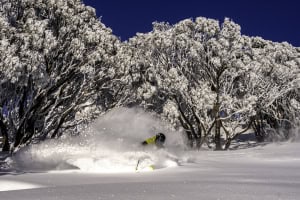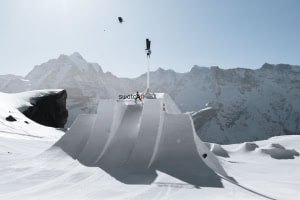A High Flying Life

Olympic aerialist David Morris in action. Image – Getty Images
Words – Don St Pierre
Many only see winter sports once every four years when the Winter Olympics rolls around and even that is probably only on television.
One of the more absurd sports for the uninitiated would have to be freestyle aerials. Who are these insane people who do such ridiculous things with their bodies? It’s not a sport; it’s a circus! Why not shoot them out of a cannon? What makes anyone think they can ski – faster than a car on a city street – into a 56 degree kicker standing over two metres tall, to launch themselves more than 15 metres into the air to perform three flips with multiple twists then land like they’ve just stepped off a bus in the CBD?
Of all the skiing disciplines freestyle aerials requires more acrobatic skills than actual skiing skills, making it a winter sport Australia has been able to excel at. The Flying kangaroos aerials team have two Olympic golds and one bronze along with countless World Cups, World Championships and even world records between their three outstanding stars – Jacqui Cooper, Alisa Camplin and now Lydia Lassila Teammates Liz Gardner and Bree Munro are also amongst the World’s Best.

Image – Liz Gardner
Skiers or Gymnasts
Australia’s aerials girls were gymnasts, headhunted by the developing aerials program run in Mt Buller in the late 1990s.
“Before 1999 I had never skied and Lyd (Lydia Lassila) had been a recreationally skier with her family for a few years,” recalls Liz Gardner. “We initially had to see if, number one, we could even ski and number two, whether we liked this cold white stuff. Both us took to it like fish to water or snow lions to mountains. We were absolutely in love with skiing and the challenge to learn and master a new sport was quite a big motivation.”
To develop the gymnastic tumbling and acrobatic skills into the aerial tricks needed in aerial skiing, the girls took to water jumps. The ‘dry slope’ jumps – with a synthetic skiable surface – launch into water landings, making them safer for practicing new maneuvers.
Hundreds of jumps are performed on water before moving on to snow and each National Governing Body sets their own standards and procedures for a safe progression from water to snow.
“Australian jumpers typically do very high numbers, I don’t know if this is our focus on perfection especially early on in a jumpers career or it is just a work ethic that is expected of us, but the first five or six years of my career I would typically do 2500 jumps,” says Gardner.
“One year I worked this out to be climbing up and down Everest 3 times in one summer!” (Because of all the stairs climbed to reach the top of the jump platforms for each jump)
For most of us it’s hard to imagine how these aerialists perform such incredible jumps on snow and few of us have the chance to stand at the start of one of these triple kickers and look down at the jump. If you have than you know it’s close to suicidal imagining yourself actually leaving the start gate and skiing into the kicker.

World Cup aerial jumps. Image – Liz Gardner
Serious training
Liz Gardner’s daily schedule:
7am Wake up
7.30-8.30am Warm-up – Ride bike, ballistic drills, core, pilates circuit and stretching.
8.30-9.30am Bungee and trampoline – working on technical details, twist timing, new tricks, body tension.
9.30 – 12pm Water ramping – doing from 10-25 jumps a session.
12 – 2pm Lunch and usually a nap!
2-2.30pm Warm-up – Light warm-up ride bike and get the body moving.
2.30 – 4pm Water ramping – 10-25 jumps, usually goes quicker in the afternoon, less people around and everyone is already warmed up from the morning.
4-4.30pm Video review, time with coach to discuss days training and set goals for next day.
4.30-5.30pm Sport pysch – journaling, visualization and goal setting.
5.30-7pm Gym workout – anything from weights, cardio, recovery or core sessions. Depending on the focus at the time.
7-8pm Dinner – hang out with team mates.
8-9pm Wind down time – chat to family, relaxation, start watching a movie.
9pm Bed – get ready to start the day all over again!

Image – Courtesy Liz Gardner
Love and hate
“There are times when I absolutely hate what I do and question why I do it, but then there are perfect days when I can’t wipe the grin off my face and know I am having the best life I could possibly have,” says Gardner.
“What I hate the most is being cold, being constantly scared and having to deal with weather conditions everyday. What I love is the feeling of soaring through the air when you hit a perfect jump and you are just in complete control in the air, time stands still and this is the most rewarding feeling in the whole entire world and yes of course landing this jump. This is what we train for and when you get it right it makes everything worth it.”
Contact sport
Aerials is also a contact sport with the landing hill. It’s equivalent to falling out of a three story building and even though the landing hill is about 37 degrees in pitch to minimize impact it still leaves a mark when you land on your back or come in short and take it on the chin. If you’re standing by the landing hill of an aerial jump you can feel the impact through your feet and hear the air leave their lungs as they smack to their
“I have patellar tendonopthy, patellar femoral and a grade 2 MCL tear on my left knee, constant SI instability, bone damage in both ankles, I had a headache and neck problems for 7 months straight, a few concussions and the constant string of muscle contusion, sprains and aches,” lists Gardner.
Love and struggle
So what’s it all about? What lures these athletes and captivates them, returning season after season like Jacqui Cooper with 18 years of World Cup competition and Lydia Lassila and Liz Gardener going on ten years, especially in a sport that has little recognition or financial support in Australia?
“The scholarship and grants (which are earned through athlete commitment) only cover the bases of an athletes needs – all equipment, living expenses and any specialized clothing, medical expenses, travel and health insurance are left to the individual athlete,” says Gardner ” We are not only training full-time, but are living out of the country for up to 9 months a year, unable to make a living overseas. I always struggled with, having enough money to buy the equipment I needed and having to live on a shoe string budget the whole time.”
One thing stands out loud and clear with these aerial warriors is that neither Lydia or Liz regret a moment in what has been an amazing journey over the past ten years since trading in their leotards for ski boots.






